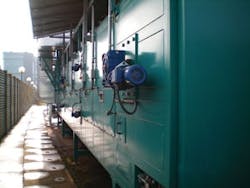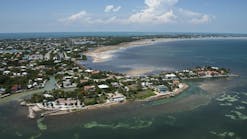By Webster Owen Jr. and Steve Herrera
In the face of stringent new effluent discharge standards, the City of Placerville, CA, converted its Hangtown Creek wastewater treatment plant into a modern, state-of-the-art nutrient removal facility that meets recycled water discharge regulations. Engineering the facility was significantly more complex and took more imagination and ingenuity than the design of most wastewater treatment plants. In addition, a number of key engineering design issues made the $45 million project challenging from a construction and scheduling standpoint.
The project incorporated a number of advanced treatment features. The effluent now discharged from the Hangtown Creek Water Reclamation Plant almost meets drinking water standards and, from an appearance standpoint, looks like drinking water.
Background
The City of Placerville, located in the heart of California's Gold Country 100 miles northeast of San Francisco, turned to Owen Psomas as program manager and engineer to upgrade its aged Hangtown Creek wastewater treatment plant. Built in 1960, the plant was previously upgraded in 1976, with minor improvements in the 1980s and 1990s.
A complete plant renovation was required to comply with new waste discharge requirements, a cease and desist order adopted in the State of California, and U.S. EPA municipal sludge treatment requirements. Improvements also were necessary to reduce operating costs and address health and safety concerns.
The project involved added nutrient removal, replacement of gaseous chlorine disinfection, and upgraded sludge digestion. The rebuilt plant included process upgrades, modifications to existing structures and a power service. Conceptual engineering started in 2002 and construction was completed in May 2009.
Design, Construction Challenges
The plant had to be kept in service, and meet waste discharge requirements throughout the nearly three-year construction period. In the words of Public Work's Director Randy Pesses, rebuilding the entire plant while keeping it in service "was like changing the blades on a blender while it is running."
The plant was kept in service using some of the existing infrastructure while other parts were replaced and sections converted to new uses.
Complicating matters was the fact that the existing treatment plant was located on a very small seven-acre site, of which 85 percent was occupied by existing structures. Close coordination was required between the design team, construction crew and plant operations. Plant operators had to safely access the entire plant while it was, in essence, being completely replaced. Major project improvements included:
New Headworks
A new headworks, located upstream of the main plant, allowed the hydraulic profile of the plant to be raised four feet without requiring added pumping. This allowed the existing primary clarifiers to be renovated by adding 50 percent more depth and increased their performance capacity to meet the new loading conditions.
The effluent discharged from the Hangtown Creek Water Reclamation Plant almost meets drinking water standards.
Since the primary clarifiers could only be taken out of service in the summer when influent flow is low and could only be taken out of service one at a time, primary clarifier work could not start until the headworks was relocated. It was necessary to carefully coordinate with plant operations to take one headworks channel out of service, put it in service in its new configuration, take the other channel out of service, and then put it into service in its new location– all before the start of the wet season.
Clarifier System Modifications
Existing concrete tanks were converted from secondary clarifiers to anoxic (denitrification) basins. New filters were added to produce tertiary filtered effluent.
Primary Clarifier System Modifications (increase clarifier depth). The existing primary clarifier structures were totally reconfigured. Depth was increased 80 percent by the use of structural changes with buttress and T-Wall reinforcing. Primary clarifiers had to be kept in service, meaning that renovation could only happen one at a time and all before the start of the wet season. The increased depth and modern, patented, mechanism design, coupled with a unique sludge pumping system improved the efficiency and avoided the necessity of building new tanks.
Secondary Clarifiers. Two new circular secondary clarifiers with patented inlet arrangements that increased capacity were added in the project. The special geometry allowed a balanced design without having to add other clarifiers to handle peak flows.
Tertiary Filters (gravity filter with upflow clarifier). Because of site constraint problems, the filter complex required unique structural revisions to two existing concrete basins to support the 340,000-lb combination clarifier/filters. These basins required structural columns and supports that had to be built while the adjacent basins remained in service. The new filters were designed in a way that the contractor could take one basin out of service, build the filter over it, and then take the other basin out of service and build the remaining filter on top. These filters now reliably produce water that has a very low transmissivity, making the disinfection process extremely efficient.
Ultraviolet Disinfection
The existing chlorine disinfection system had to continue operating until a new ultraviolet light system was installed, tested and commissioned. Testing was essential because once the chlorine system was removed there was no going back. Since disinfection is one of the key aspects of wastewater treatment, the redundancy is critical.
The new low pressure, high-output ultraviolet disinfection system will help eliminate the creation of disinfection byproducts.
Sludge Handling Facilities
The existing power-intensive aerobic digestion system, which was not sufficient to meet U.S. EPA 40 CFR Part 503 stabilization requirements, was replaced by expanding the anaerobic digestion system. In order to accomplish this task economically, the two existing aerobic digesters were converted to holding tanks, two existing anaerobic digesters were retrofitted with modern heating and mixing systems, and one new larger anaerobic digester was built.
Sequencing had to follow a very specific plan to assure there were no plant upsets, odor problems or spillage. In order to keep the solids handling system operating, the new digester with heating, mixing and pump facilities was built and put into operation, and then the existing digesters were taken offline (one at a time), renovated and put back in service.
Conventional evaporative cooling towers are used to cool secondary effluent to protect trout habitat in Hangtown Creek. The cooling towers are currently dropping the temperature 5 – 6 degrees F.
A modern gravity belt thickener was added to reduce the digester volume, and a new belt press added to provide the redundancy necessary to efficiently dewater the digested solids. The results are already apparent. Not only does the sludge meet stabilization requirements, there also is a 50 percent reduction in the volume of sludge hauled to land application, with accompanying savings on trucking and disposal.
New Operations Building
The Operations, Control and Laboratory Building, last remodeled in 1976, was undersized and insufficient for the complex testing necessary for plant operations.
An entirely new laboratory was engineered and constructed on the site of an old animal control facility. Complicating matters, the El Dorado County animal control had a lease for several buildings on the site that expired one year after construction began. Consequently, design had to allow occupancy during initial construction. The old SCADA system in the existing operations building had to be kept running until the animal control facility was vacated, the new building was constructed, and SCADA system was installed and tested.
The new facility design includes an up-to-date computerized SCADA control system in which the operators can monitor all aspects of the plant.
Advanced Treatment Features
The project incorporated a number of advanced treatment features, including:
- Effluent Cooling Towers: One of the more unusual aspects of this plant is the need to cool effluent seasonally (typically between April and November of each year) to enhance trout habitat in Hangtown Creek. Conventional evaporative cooling towers were specially engineered for cooling secondary effluent using variable speed pumps and fans. The cooling towers are currently dropping the temperature 5 – 6 degrees F.
- Aeration System Modifications: A modern Modified Ludzak-Ettinger (MLE) biological nutrient removal process with step feed and high-flow bypass process options for high flow, low TKN was added to meet stringent, year-round nutrient standards.
-Overall Process Upgrade: The upgraded primary, secondary and tertiary processes, coupled with the upgraded anaerobic digestion system, has allowed for substantial decreases in effluent concentrations for heavy metals (including copper, aluminum and zinc) and dissolved solids.
Award-Winning Results
The 2.3 mgd Hangtown Creek Water Reclamation Facility now treats peak flows in excess of 10 mgd (maximum day flow of 5.7 mgd) and discharges tertiary treated effluent to Hangtown Creek.
The project included installation of a Modified Ludzak-Ettinger biological nutrient removal process to meet stringent, year-round nutrient standards.
Performance of the facility has resulted in improved water quality, as well as air and land quality. Far less chemicals are being used and there is a significant reduction in trucking costs and solids production. Project improvements have resulted in:
- operating costs for electricity and chemicals have decreased by 20 – 30%
- consistent compliance with low nitrate nitrogen and coliform bacteria limits
- extremely high effluent transmissivity (72%). The transmissivity of the tertiary filter effluent averages 80%
- turbidity of the tertiary filter influent averages 0.5 NTU
- substantially reduced copper (reduced by 40 – 50%), zinc (reduced by 20 - 30%) and dissolved solids concentrations
- operating costs reduced $200K/year
In recognition of the engineering design issues and advanced treatment features, the project has won numerous awards, including Wastewater Project of the Year from the American Association of Civil Engineers – California, the 2009 Engineering Achievement Award from the California Water Environment Association – Sacramento, and one from the American Academy of Environmental Engineers. WW
About the Authors: Webster Owen Jr., senior vice president, led the Owen Psomas Team in the planning, permitting, design and construction management of the Hangtown Creek Water Reclamation Facility. Steve Herrera, was the assistant project manager/ senior project engineer. Other subconsultants included: Orris E. Albertson, process consultant; SPH Associates, filtration consultant; Interface Engineering, electrical/instrumentation; ANOVA Architects, Inc., architectural; and Youngdahl Consulting Group, Inc., geotechnical.
More WaterWorld Current Issue Articles
More WaterWorld Archives Issue Articles



